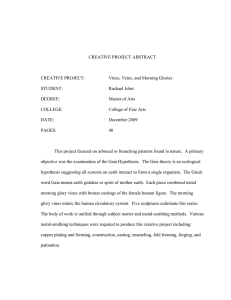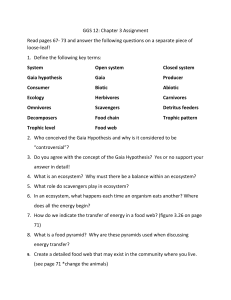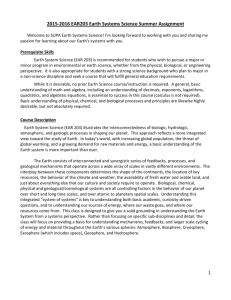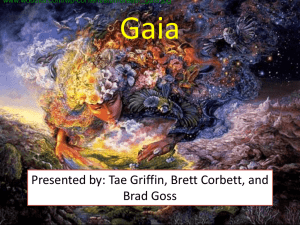Transients and alerts with Gaia Łukasz Wyrzykowski eSI, QUB, Belfast, 20 January 2010
advertisement
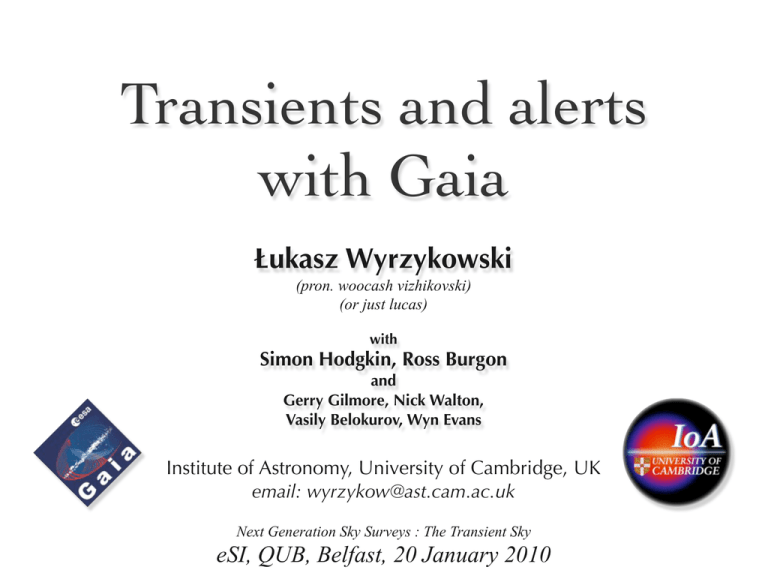
Transients and alerts with Gaia Łukasz Wyrzykowski (pron. woocash vizhikovski) (or just lucas) with Simon Hodgkin, Ross Burgon and Gerry Gilmore, Nick Walton, Vasily Belokurov, Wyn Evans Institute of Astronomy, University of Cambridge, UK email: wyrzykow@ast.cam.ac.uk Next Generation Sky Surveys : The Transient Sky eSI, QUB, Belfast, 20 January 2010 Gaia: Complete, Faint, Accurate Łukasz Wyrzykowski, IoA Cambridge UK Gaia Science Alerts Satellite and System ESA-only mission Launch date: spring 2012 Lifetime: 5 years (1 year potential extension) Launcher: Soyuz–Fregat from CSG Orbit: L2 Lissajous orbit Ground station: Cebreros and New Norcia Downlink rate: 4–8 Mbps • Mass: 2120 kg (payload 743 kg) • Power: 1631 W (payload 815 W) Figures courtesy EADS-Astrium Łukasz Wyrzykowski, IoA Cambridge UK Gaia Science Alerts Scanning law • • • • Two telescopes - time between subsequent FOVs: 106.5m Time between successive scans: 6 h Field revisited every ~70 days Each object measured ~80 times (200 at the nodes) Lukasz Wyrzykowski, IoA Cambridge UK Gaia Science Alerts Gaia’s Focal Plane • • Chip transit: 4.4s Field transit (9 astrometric CCDs): 40s Lukasz Wyrzykowski, IoA Cambridge UK Gaia Science Alerts Science Alerts aims: • detect unexpected and rapid changes in the flux • or appearance of new objects • trigger ground-based follow-up • provide targets to the community to be studied at peculiar states methods: • run in near-real-time: between couple of hours and 24h after observation • use photometric data, calibrated roughly • release of an alert through VO Łukasz Wyrzykowski, IoA Cambridge UK Gaia Science Alerts Aims Łukasz Wyrzykowski, IoA Cambridge UK Gaia Science Alerts GRBs optical counterparts Potential Triggers R Coronae Borealis FU Orionis and similar M-dwarf flares Be stars Microlensing events Supernovae Asteroids Dwarf novae NEW THINGS?? Classical novae Łukasz Wyrzykowski, IoA Cambridge UK Lensed supernovae Gaia Science Alerts Rates of alerts (preliminary) contaminants(?) interesting alerting object 5-yrs (Entire Mission) main location Supernovae <19 mag 6000 out of plane Microlensing (bulge) ~1000 bulge/plane Microlensing (all sky) ~700 out of plane GRB optical counterparts ~hundreds (?) out of plane R CrB-type stars ~hundreds (?) gal. plane CN 150 gal. plane FU Ori 14 gal. plane Eclipsing binaries a million (?) gal. plane AGNs 500,000 (?) out of plane Asteroids thousands (?) out of plane Be stars thousands (?) gal. plane Long period variables/Miras thousands (?) gal. plane M-dwarf flares 2000 gal. plane DN (U Gem) (except rare big flares) 500 (?) gal. plane Łukasz Wyrzykowski, IoA Cambridge UK Gaia Science Alerts Supernovae • • 6000 SNe to G=19 Around 1/3 before maximum • Successive transits will measure consistency and slope. • Host galaxy 40s to cross the FOV 106.5 mins between FOVs Field revisited after 6 hours Łukasz Wyrzykowski, IoA Cambridge UK contribution determines whether source is new to Gaia. Gaia Science Alerts Microlensing Events • >3000 events expected to occur towards the bulge, but many lost due to crowding (exception: Baade’s Window) • ~ 700 events expected over all sky • photometric alerts on 1000+ events • ~100% long events detected - the most interesting ones (nearby or massive lens) time scale = 100 days time scale = 15 days Gaia microlensing detection efficiency on the rise OGLE-III microlensing events as seen with Gaia efficiency 0 0.2 0.4 0.6 0.8 Figure 1: OGLE’s microlensing events as would have been observed b indicate the data points taken during the actual event. Shown are events wi points during the event more than 20. When alerted in time and followed-up: ★ luminous and dark mass distribution in the Galaxy ★ dark matter in compact objects ★ extra-solar planets Technical Note Łukasz Wyrzykowski, IoA Cambridge UK Gaia Science Alerts R CrB-type stars • very few known (~50), but ~3000 expected • can drop up to 8 mag in brightness over a week! - ideal time-scale for Gaia sampling • mechanism of these dimmings remains unknown • most found in the Bulge and MCs by microlensing surveys EROS, MACHO, OGLE • ASAS (all sky) provided some new findings, limited by 14mag • Science Alerts will easily find new much fainter RCrB • spectroscopic follow-up during the event can help solving their mystery Łukasz Wyrzykowski, IoA Cambridge UK Gaia Science Alerts Other interesting triggers ✦ Classical and recurrent novae - potential distance indicators - can be detected in MW and other galaxies - large amplitudes, wide range of time-scales ✦ FU Orionis/EX Lupi - unstable pre-MS stars - rare class (few known) - several magnitudes up - X-ray variability - long time-scales - FU Ori repeats every ~40 years! ✦ Gravitationally lensed distant supernovae - unique uniform all-sky monitoring - high redshift SNe rates, distances, H0 Łukasz Wyrzykowski, IoA Cambridge UK Gaia Science Alerts Common and not interesting(?) ➡ Asteroids - loads! - faster ones can be removed after second FOV transit - predominantly known asteroids - the orbits will be calculated and new objects will be cross-matched ➡ Be stars - low amplitudes, blue colours ➡ Dwarf Novae - low amplitudes, repeating ➡ and many more... Łukasz Wyrzykowski, IoA Cambridge UK Gaia Science Alerts Monitoring System (Watch List) ‣ monitoring of known anomalous objects ‣ easily coded - just add an object to the list of alerts ‣ many of the things we alert on will be subsequently monitored ‣ but some will not alert (e.g. highly variable), but are known to be anomalous ‣ for example: known RCrB stars can be monitored in order to alert on a dimming event ‣ TBC if in agreement with the Gaia data policy Methods Łukasz Wyrzykowski, IoA Cambridge UK Gaia Science Alerts Science Alerts operation scheme New Data Photom. processing within 1 day and are stored • Detection is run on data calibrated with the most recent calibration available Data Ingestion Database • Numerous detection algorithms are used Calibs. Photom. Flux Alert Detector Candidate Alerts Curator • SDSS • 2MASS • NED • ASAS • OGLE • New Data arrive to Cambridge after basic pre- Asteroids Gaia data Classifier Catalogues Cross-match Classifier + Gaia pre-launch catalogue Publisher Łukasz Wyrzykowski, IoA Cambridge UK Detection Algorithms • Candidate alerts are classified using Gaia data • Sources are cross-matched with available catalogues and classified further • Cross-matched asteroids are removed • Alerts are stored on the Server and released Gaia Alerts Server VOEvent Gaia Science Alerts Detection: the simplest algorithm Mean History threshold History False alert Łukasz Wyrzykowski, IoA Cambridge UK Gaia Science Alerts Curation - Gaia Classification: data used in Decision Tree - G-band photometry (light curve) - BP/RP colour - raw BP and RP spectra (classification using Self-Organizing Maps) - morphology of the source (galaxy/star) - source motion flags (fast asteroid?) - Gaia catalogues (later in the mission) - galaxies - variable stars classified into types - astrophysical parameters, e.g. Teff, spectral type Łukasz Wyrzykowski, IoA Cambridge UK Gaia Science Alerts Curation - Cross-matching uses existing catalogues available through Virtual Observatory, Astrogrid or local copies, e.g. SDSS, 2MASS, NED, ASAS, OGLE - star, source close to galaxy or orphan new source? - magnitudes and colours in optical and IR - X-ray source, gamma source? - time-domain photometry - variability classification (e.g. recurrent nova, eclipsing) - asteroids flagged by other Gaia units - anomalies alerted by other surveys (e.g. GRBs alerts) Łukasz Wyrzykowski, IoA Cambridge UK Gaia Science Alerts Outreach with Science Alerts ๏ Science Alerts can be exciting not only for professionals ๏ a platform (EU RTN) will be build to provide alerts to the general public ๏ not only alerts, but also tools for observing, data reduction, studying ๏ cool projects, e.g. “Adopt a Supernovae” ๏ amateurs, schools, universities... Łukasz Wyrzykowski, IoA Cambridge UK Gaia Science Alerts Challenges and requirements ๏ Data storage and access Science Alerts will independently store all raw observations from the entire mission. This is about 1012 measurements (~20TB). Storing and access must be as quick as possible. ๏ Processing speed Also data processing must be quick. About 107 objects will be checked every day. Parallel processing needed. ๏ Design of detection algorithms and classification of alerts Remove spurious detections (most of the alerts!), classify, attach a priority ๏ Fine-tuning of the detection and classification procedures In the first 3 months of the mission the alerts will not be released and will be internally verified in order to fine-tune the procedures. After that still some minor fine-tuning will be required. ๏ Well organised follow-up network Gaia is a survey-only telescope with relatively poor sampling. Without a follow-up its alerts, in most cases, will be meaningless. Łukasz Wyrzykowski, IoA Cambridge UK Gaia Science Alerts http://www.ast.cam.ac.uk/research/gsawg/ Łukasz Wyrzykowski, IoA Cambridge UK Gaia Science Alerts Preliminary Advert Science from Gaia Alerts workshop supported by GREAT (Gaia Research for European Astronomy Training) Cambridge, 23-25 June 2010 more info soon on Gaia Science Alert WG wiki: http://www.ast.cam.ac.uk/research/gsawg/ Łukasz Wyrzykowski, IoA Cambridge UK Gaia Science Alerts
